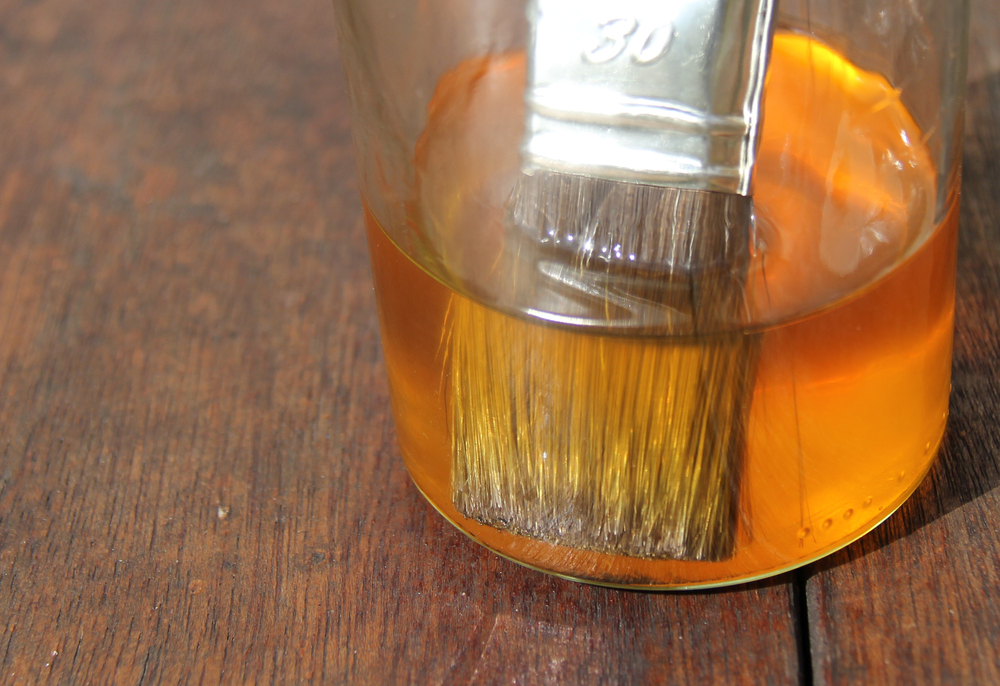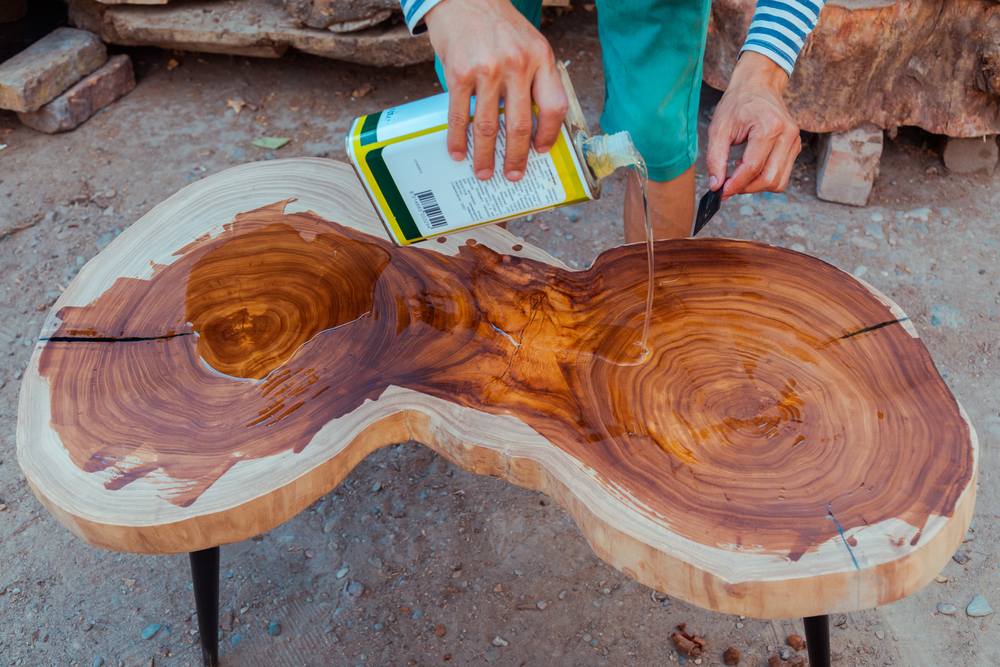Linseed oil is derived from the flax seed and is a hugely popular finish for wood products worldwide.
It is a vital component of any woodworker’s toolbox, no matter their skill level or whether they are looking to preserve interior or exterior wood!
There are two types of Linseed oil – Raw linseed oil and Boiled linseed oil – and each type has its own unique characteristics and properties which make them better suited for slightly different applications.
Choosing between the two options could seem like a confusing task, but this article aims to unpack some of these differences in order to help you make a more informed choice about finishing your woodwork project. We’ll discuss:
- What raw linseed oil and boiled linseed oil are
- The key differences between the two.
Let’s get started!
Table of Contents
What is Raw Linseed Oil?

Raw linseed oil (not to be confused with flaxseed oil) is linseed oil in its purest form. It is an incredibly popular option for finishing wood surfaces, having been a mainstay in the toolboxes of handy people of all shapes and sizes for hundreds of years.
Raw linseed oil’s natural composition, untampered by other chemicals or additives, gives it more subtle, elegant properties.
This makes it a favorite for ornate interior furnishings such as antique furniture and cabinetry. When you want an authentic, understated, yet classy finish, raw linseed oil is the product for you!
A key consideration when deciding whether to work with raw linseed oil is the dry time and reapplication involved.
When opting for this type of linseed oil, keep in mind that it will require up to 3 days of dry time and semi-regular attention.
Raw linseed oil also provides a brilliant protective coating for oil-based paints, offering a glossier, smoother finish.
What is Boiled Linseed Oil?
Unlike raw linseed oil, boiled linseed oil is treated with a couple of different substances to promote faster drying times and therefore more versatile usage on multiple different types of jobs.
This treatment involves combining it with additives and blowing hot air through it in order to speed up the drying process.
Contrary to what its title may lead you to believe, this type of linseed oil isn’t actually boiled! The process of circulating hot air through it is the reason for its namesake.
The additional components added to boiled linseed oil give the wood it is treated with a glossy, premium sheen. The extra ingredients also ensure that tacky finishes are a thing of the past.
Commonly used on outdoor projects such as garden furniture and even wooden boats, this type of linseed oil is the right choice if you’re looking for a darker, almost wet look.
While the benefits of Boiled linseed oil are convenience and a premium finish, it is also important to keep in mind that the chemicals added in the treatment process are known to be somewhat hazardous.
While Boiled linseed oil is safe to touch once dry, it is toxic upon ingestion and therefore should not be used on food preparation surfaces.
Raw vs Boiled Linseed Oil: Key Differences

Now we’ve unpacked the basics of each type of Linseed oil and its different properties, let’s have a more in-depth look at 5 key factors to consider when looking for a wood finishing product and how each type of linseed oil compares!
Drying Time
This is one of the crucial differences between Raw and Boiled Linseed oil.
Due to its treatment process, Boiled linseed oil offers a much speedier drying option in any condition.
While raw linseed oil can take up to 3 days to dry properly, its boiled counterpart usually clocks in at about 24 hours.
This marked difference is definitely something to take into consideration on a time-sensitive project.
If you’re working within stricter time constraints, Boiled linseed oil is going to be the better option.
Color and Finish
If time constraints aren’t an issue and you value a natural finish that complements the intricacies of the wood you’re working with, then Raw linseed oil may provide just the finishing touch you’re looking for.
Finishes like this offer a rustic yet vivacious feel to your project.
In comparison to a more understated finish, Boiled linseed oil will transform your project with a stunningly rich finish. If you’re after a bold, unapologetic look, Boiled linseed oil offers a fine option.
Durability and Safety
Both types of linseed oil offer more than adequate protection against the elements.
However, Raw linseed oil is more likely to require reapplications down the line than Boiled linseed oil is.
Therefore, the location of your project is something to take into consideration when choosing between these two options; boiled linseed oil is generally favored for more robust, exposed surfaces.
As far as safety is concerned, unaltered Raw linseed oil is considered the better option when used on surfaces that come into contact with food.
The processes and extra components involved in the manufacturing of Boiled linseed oil make it toxic in these circumstances.
An important piece of information to keep in mind: both types of linseed oil involve a risk of spontaneous combustion!
Ease of Use
Both types of linseed oil are easy to apply initially. All that is required is a paintbrush and an eye for detail!
However, beyond the initial application, the quicker drying time of boiled linseed means it is considerably more convenient to work with – especially in a time-sensitive context.
As far as clean-up is concerned, it is advised that you keep mineral spirits and a couple of rags nearby to tend to spills of either variant of linseed oil and to keep your brushes in good condition.
It is important to understand the requirements of the project you have at hand and choose between the two options accordingly.
As mentioned before, Raw linseed oil’s natural properties mean that it may need more frequent touch-ups.
Conversely, Boiled linseed oil offers a stronger finish for longer – ultimately making it the easier of the two types of oil to use.

Finishing Thoughts
This article offered a detailed look into the similarities and differences between Raw and Boiled linseed oil.
Hopefully, with this information in mind, you’ll now be in a better position to make a decision about the finish you want to achieve and the type of linseed oil you’ll achieve it with.
To woodworkers young and old, experienced and fresh: good luck!
FAQs
Is Raw Linseed Oil Food Safe?
Yes. Raw linseed oil is considered safe to use on surfaces that come into contact with food.
What Is Raw Linseed Oil Used for?
Raw linseed oil is applied to wood to give it a natural finish and to accentuate its properties.
Is Boiled Linseed Oil Actually Boiled?
No, boiled linseed oil is not actually boiled! It got its name because the process required to make it involves blowing hot air through the oil, which speeds up drying time.
Is Boiled Linseed Oil Food Safe?
No. Due to the processes used to create it, boiled linseed oil is toxic and unsafe for use on surfaces that come into contact with food.
What Is Boiled Linseed Oil Used for?
Boiled linseed oil is applied to the wood to give it a glossy sheen. It is a popular alternative to raw linseed oil due to its shorter dry time.
